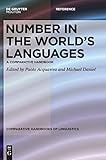Number in the World's Languages : A Comparative Handbook / ed. by Paolo Acquaviva, Michael Daniel.
Material type: TextSeries: Comparative Handbooks of Linguistics [CHL] ; 5Publisher: Berlin ; Boston : De Gruyter Mouton, [2022]Copyright date: ©2022Description: 1 online resource (X, 936 p.)Content type:
TextSeries: Comparative Handbooks of Linguistics [CHL] ; 5Publisher: Berlin ; Boston : De Gruyter Mouton, [2022]Copyright date: ©2022Description: 1 online resource (X, 936 p.)Content type: - 9783110560695
- 9783110619546
- 9783110622713
- 415.5
- online - DeGruyter
- Issued also in print.
| Item type | Current library | Call number | URL | Status | Notes | Barcode | |
|---|---|---|---|---|---|---|---|
 eBook
eBook
|
Biblioteca "Angelicum" Pont. Univ. S.Tommaso d'Aquino Nuvola online | online - DeGruyter (Browse shelf(Opens below)) | Online access | Not for loan (Accesso limitato) | Accesso per gli utenti autorizzati / Access for authorized users | (dgr)9783110622713 |
Frontmatter -- Contents -- List of authors -- 1 Number in the World’s Languages: Configuring the variation space -- I Africa -- 2 Number in Eastern Dan -- 3 Number marking in Karko and Nilo-Saharan -- 4 Number in Tswana -- II Europe and Middle East -- 5 Number in Arabic -- 6 Number in Occitan -- 7 Number in Slovenian -- 8 Number in West Circassian -- III Northern Eurasia -- 9 Number in Ket (Yeniseian) -- 10 Number in Nganasan -- 11 Number in Nivkh -- IV Pacific and Australia -- 12 Number in Gooniyandi -- 13 Number in Indonesian -- 14 Number in Japonic Family -- 15 Number in the Languages of the Lower Sepik Family -- 16 Number in Marori -- V Americas -- 17 Number in the languages of South America -- 18 The category of number in Kakataibo (Panoan) -- 19 Grammatical simplexity: Number in Kiowa -- 20 Number in Mohawk (Iroquoian) -- VI Further perspectives on linguistic diversity -- 21 Contact languages: A survey -- 22 Number in Russian Sign Language -- 23 Number in grammar: results and perspectives -- Terms -- Languages and language families -- Authors
restricted access online access with authorization star
http://purl.org/coar/access_right/c_16ec
The strong development in research on grammatical number in recent years has created a need for a unified perspective. The different frameworks, the ramifications of the theoretical questions, and the diversity of phenomena across typological systems, make this a significant challenge. This book addresses the challenge with a series of in-depth analyses of number across a typologically diverse sample, unified by a common set of descriptive and analytic questions from a semantic, morphological, syntactic, and discourse perspective. Each case study is devoted to a single language, or in a few cases to a language group. They are written by specialists who can rely on first-hand data or on material of difficult access, and can place the phenomena in the context of the respective system. The studies are preceded and concluded by critical overviews which frame the discussion and identify the main results and open questions. With specialist chapters breaking new ground, this book will help number specialists relate their results to other theoretical and empirical domains, and it will provide a reliable guide to all linguists and other researchers interested in number.
Issued also in print.
Mode of access: Internet via World Wide Web.
In English.
Description based on online resource; title from PDF title page (publisher's Web site, viewed 25. Jun 2024)


